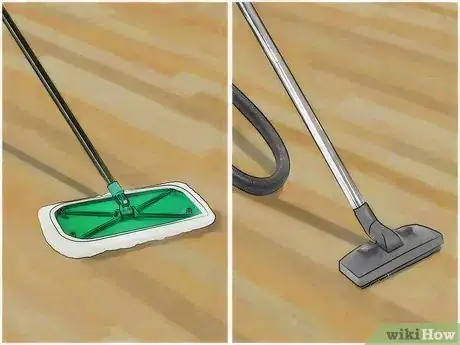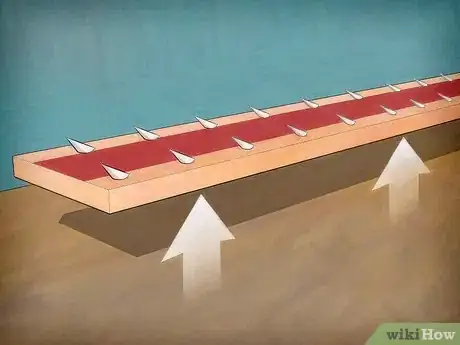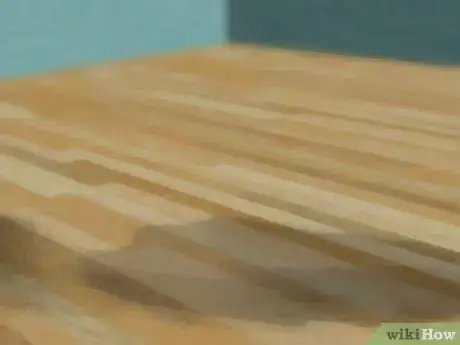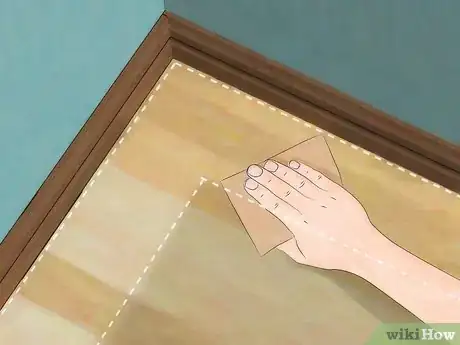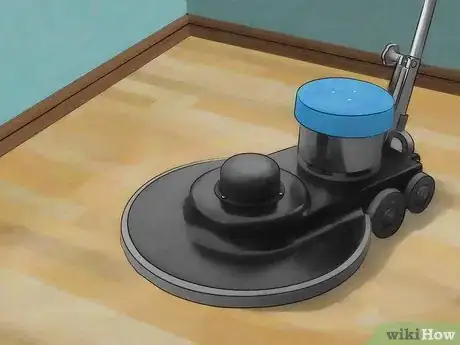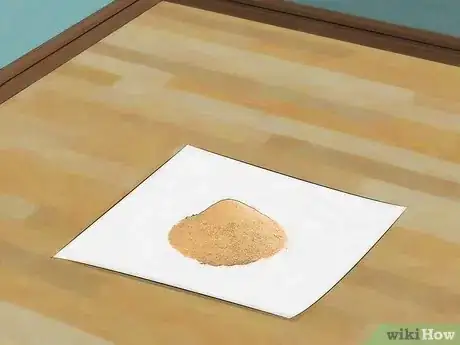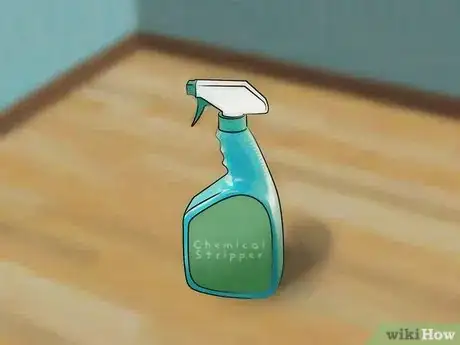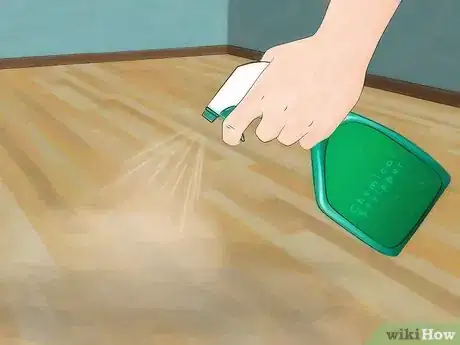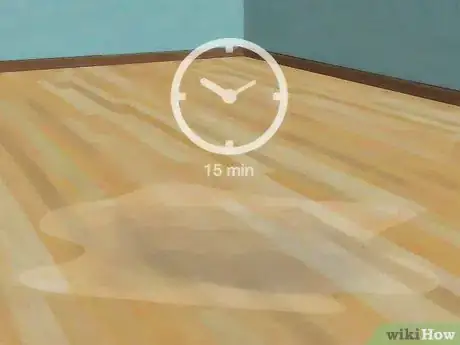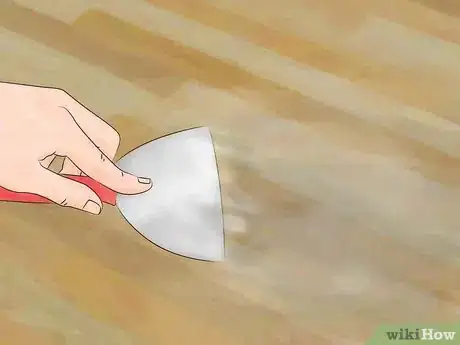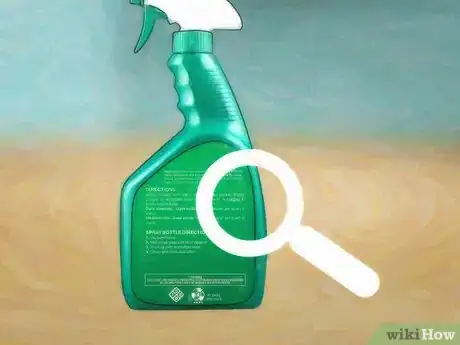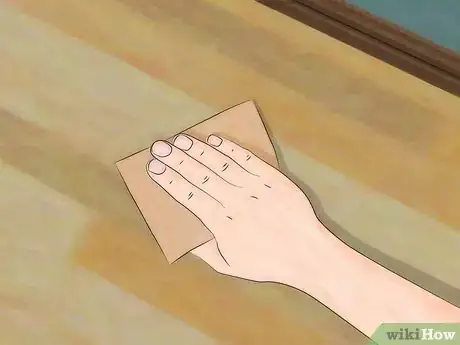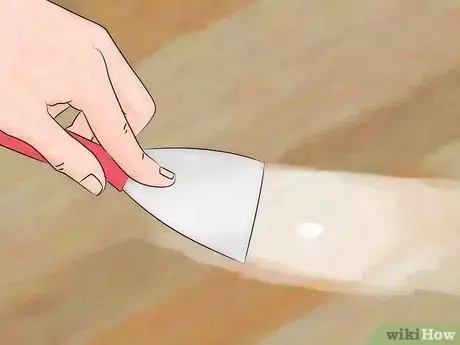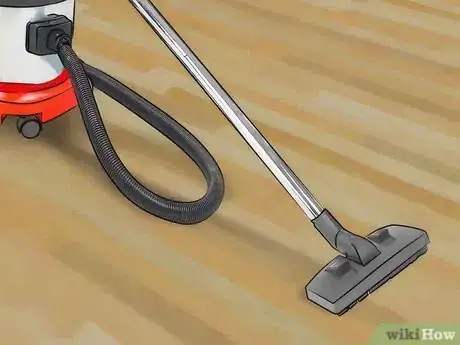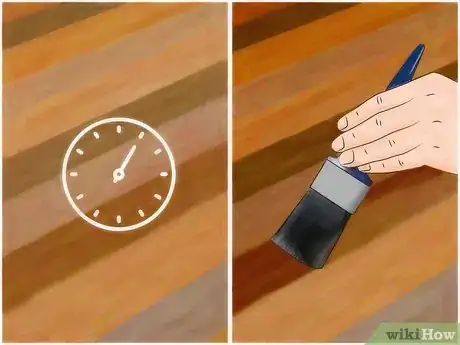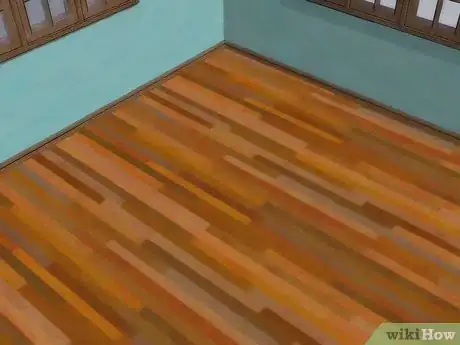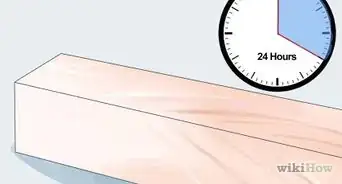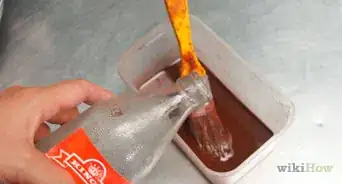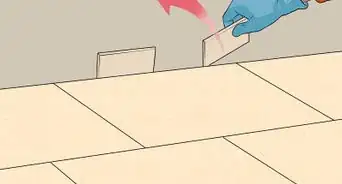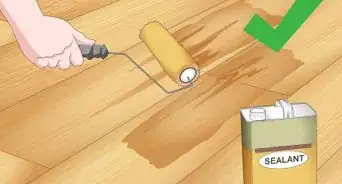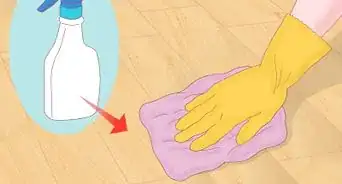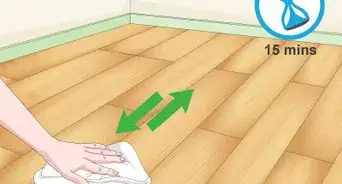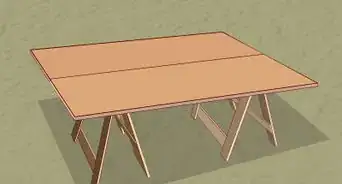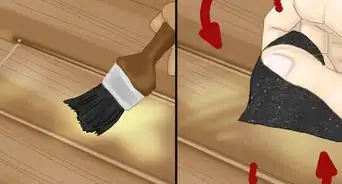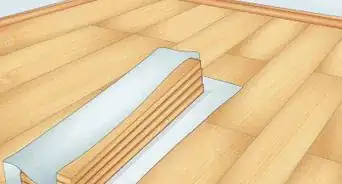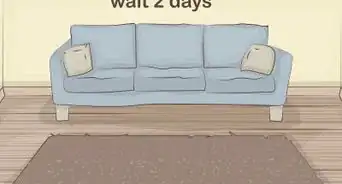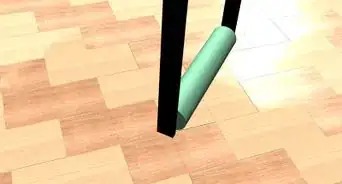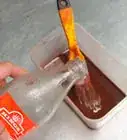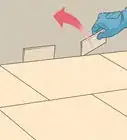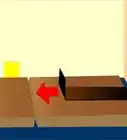This article was co-authored by Mark Spelman. Mark Spelman is a General Contractor based in Austin, Texas. With over 30 years of construction experience, Mark specializes in constructing interiors, project management, and project estimation. He has been a construction professional since 1987.
wikiHow marks an article as reader-approved once it receives enough positive feedback. In this case, 92% of readers who voted found the article helpful, earning it our reader-approved status.
This article has been viewed 425,522 times.
Under old, soiled, dirty carpet may be a beautiful wood floor screaming to be reintroduced to your home. Coating your floors with a clean, new finish is about as satisfying as it gets. A little hard work and you could have the hardwood floor you've always wanted.
Steps
Prepping Your Floor for Refinish
-
1Remove any carpeting from the area. Cut and roll in sections manageable for carrying out to the trash. Once all carpeting has been removed, move on to the real work.
- If any of the carpet is stuck to the subfloor, then you may need to scrape it or just give it a good tug to get it unstuck.
-
2Hammer down any protruding nail heads. Nails may have been added to the flooring to cut down on squeaking or to secure a loose baseboard. Either way, nails that are sticking up above the wood floor present both a danger and a nuisance. Most of the time, hammering the nails down deeper into the flooring is a better and easier solution than taking the nails out.
- Hammer the nails down about 1⁄4 inch (0.6 cm) into the floor. Use a nail set so you don't leave hammer marks(dents)in the wood. Work with their direction, not against it. Once the nails are 1⁄4 inch (0.6 cm) deep, they're ready to be concealed with a little bit of filler that you'll make after sanding down the rest of the flooring. More on that later.
Advertisement -
3Make sure the floor is relatively clean.[1] If old carpet backing is stuck to your wood floor, you will need to scrape it off with a putty knife. This can be a rather tedious job, and can take a great deal of time, but it's worth it.
- Go over the floor with a vacuum and mop if necessary. Years of dust and grit can create a lot of debris. You want this debris cleared away before you attack the old wood finish.
-
4Remove any tack stripping along the floor edges. If tack stripping was present along with your carpet, remove it before you start sanding so that you can hit those areas with your finish.
Removing the Old Finish by Sanding
-
1Use sanding to buff up any very old, excessively scratched or worn wood. Chemical strippers can be used if what you're after is a quick fix, or the floors themselves were recently finished. If, however, you're dealing with traffic patterns, stains, or scratches, your best bet is to sand away those imperfections and then add another coat to the floor.[2]
- You can rent a detail sander for this purpose.
-
2Prep the perimeter. Hand-sand or palm-sand the perimeter of the floor with coarse 180-grit sandpaper. Rub out 4 to 6 inches (10.2 to 15.2 cm) from the edge of the baseboard so that you're sure to cover the areas your mechanical floor sander can't get to.
-
3Use a floor sander. A floor sander is useful to hit the areas of the floor that weren't hit by hand in the detail sanding. You can rent floor sanding machines at hardware supply stores or equipment rental stores.[3]
- Start with a semi-coarse grit and begin to sand the floor. Start off gently. You don't want to gouge the floor. If you get a good sander, you'll even be able to lift up the sander and spend a little more time on heavy-wear or problem areas. Change out your sanding disks as necessary. You may need to change out the sandpaper once or twice using the same grit before you've completely removed the finish.
- Using a pencil, color the entire area lightly with streaks of graphite. This will help tell you when you've sanded an area. Otherwise, it'll be tough to tell where you've sanded and where you haven't.
- Go over the entire floor again with a medium-grit sandpaper. Look at the pencil streaks to determine whether you've already sanded an area or not. Again, you may need to change the disks on your sanding machine before the job is finished.
-
4Save the sawdust created by sanding. If you hit any wayward nails back into the floor in the prep stage, be sure to save the sawdust so that you can patch and plug the 1⁄4 inch (0.6 cm) holes created by the nails. This will help ensure a nice, even finish.
Removing the Old Finish with a Chemical Stripper
-
1Use a chemical stripper in lieu of sanding. If you have a very small 12” by 12” area to refinish, then you may want to use a chemical stripper instead of sanding down the floor. If you choose to use a chemical stripper, always follow the instructions on the label and use proper safety precautions.
- Use gloves, goggles, and be sure to ventilate the area you're working in. Chemical strippers are designed to peel off the finish from wood; you don't want it interacting with your skin, and you don't want to inhale too much of it.[4]
-
2Apply the stripper on an area of about two square feet. Don't be timid about applying too much of it. You also don't want to cover too much of an area at once as you will want to be able to clean the area in plenty of time.
-
3Let stripper sit for about five minutes. Once you've applied the stripper to the finish, let wait the suggested time without interfering. You will notice the old stain bubbling and lifting from the wood.
- Don't wait so long that the stripper dries on you. When you remove the stripper, you want it to still be wet.
-
4Remove the stripper from the wood. You can do this in two steps:
- Hit the area with a putty knife to scrape off the stripper along with the finish.
- Use denatured alcohol in a disposable aluminum pan to clean off the remaining stripper with the help of steel wool. Do not put too much denatured alcohol in the pan, as it does tend to quickly evaporate.
-
5Follow manufacturer's instructions for cleaning the stripper from the wood. Different chemical strippers will need to be cleaned using different methods. Some strippers need to be cleaned with turpentine or paint remover, while others can simply be rinsed with water.
-
6Allow the area to dry completely. Water or moisture and your new finish don't work well together; be sure to allow the area to dry completely before moving on to the next step.
-
7Spot-sand any scratched or worn areas. You may need to sand any problem areas before you apply the new finish to your wood floors.
Applying the New Finish
-
1Plug any remaining holes with wood paste or wood plugs. May you had a few cables running into the baseboard; or perhaps those nails we talked about earlier are in need or covering up.
- To make a wood paste, mix sawdust with a small amount of white glue to create a paste. Apply paste over the nails with a putty knife and allow to harden before sanding flush with the rest of the floor.
- Find small wooden plugs for larger holes. If necessary, drill into the floor to enlarge the hole so that the plug will fit nicely inside. Apply a small amount of wood glue around the side of the plug, fit the plug into the hole so that the grain of the plug and the grain of the floor match well, and hammer down lightly. Allow to dry completely before sanding flush with the rest of the floor.
-
2Clean the floor. Before you apply any finish, be sure to vacuum and/or clean up any debris. You want your entire floor cleared of any sawdust, debris, or stripper before you apply the new coat. Make sure also that your floor is completely dry before applying the new finish.
-
3Apply the stain. Once the floor is ready to be refinished, apply the water-based stain or finish of your choosing evenly onto the floor. Make sure that before you actually start to apply the coat to your floor, you have the windows open for ventilation, you're wearing a mask to keep the fumes from bothering you, and you've spot tested the finish so you reasonably know what it's going to look like on your floor.[5]
- Also use gloves and a synthetic bristle brush when applying the finish. Start with the perimeter of the floor and work your way in. A 3-inch band is all you'll need for a perimeter.
- Use a lamb’s wool applicator pad to do most of the work for you.[6] You can use a watering can with a bit of cheesecloth on top to pour the finish onto the floor, and then use your applicator pad to mop the finish into the floor evenly and cleanly.
- Make sure that you leave yourself an area to exit once the finish has been applied. You don't want to have to walk over the newly-stained floor with your dirty shoes when you want to let the finish dry.
-
4Wait for the finish to dry. If necessary, apply another coat of stain or finish to deepen the color. Use the same techniques as your first coat, but sand the area with a fine 300 grit sandpaper first. Also, be sure to take proper safety and handling guidelines into consideration.
-
5Finish with a polyurethane coating when the stain dries, if desired. It is much easier to use a long-handed roller rather than a brush, and it gives a nicer finish. It is important to lightly sand after each application with 220 to 300 grit sandpaper. Clean after each sanding with tack cloth. It may take 24 hours between applications for the polyurethane to dry and you will need a minimum of three coats for best results.
Warnings
- Be sure to follow the temperature, and weather guidelines for your products. Do not do when wet outside or below 50 °F (10 °C).⧼thumbs_response⧽
- Expect fumes. Make sure the room is well ventilated. Open a door and all, if not, most of the windows.⧼thumbs_response⧽
Things You'll Need
- Stripping agent from a hardware store. Inquire which product will be best for stripping wood floors.
- Denatured alcohol
- Steel wool
- Putty knife
- Rubber gloves that will not damage when used with stripper.
- sandpaper
- Buffing paper
- Wood stain (color of your choice)
- Stain spreader (looks like a squeegee)
- Polyurethane
- Varnish or oil
- Dust mask
- Hammer and nail set (small finish carpenter’s punch)
References
- ↑ https://www.thisoldhouse.com/how-to/how-to-refinish-wood-floors
- ↑ https://www.thisoldhouse.com/how-to/how-to-refinish-wood-floors
- ↑ https://www.thisoldhouse.com/how-to/how-to-refinish-wood-floors
- ↑ http://www.lowes.com/cd_Refinish+Wood+Furniture_39774404_
- ↑ https://www.bobvila.com/articles/how-to-refinish-hardwood-floors/
- ↑ https://www.bobvila.com/articles/how-to-refinish-hardwood-floors/
About This Article
Before refinishing your wood floors, rent a detail sander from your local home improvement store and use it to buff away the old finish. Then, plug in any holes with wood paste or wood plugs, and vacuum the floor to remove any sawdust or debris. Once the floor is ready to be refinished, use a paintbrush to apply the water-based stain or finish. Let the stain dry, then brush on another coat if you want a richer color. However, make sure to sand the area before applying the second coat to ensure a smooth, even finish. For more advice from our General Contracting reviewer, including how remove the old finish using a chemical stripper, keep reading.


